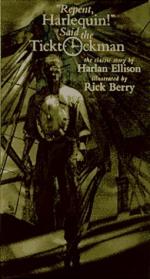|
This section contains 488 words (approx. 2 pages at 400 words per page) |

|
While Ellison's audience has largely been a popular one, academic writers also find much to say about Ellison and his work. George Edgar Slusser, for example, in an early study of Ellison's work, Harlan Ellison: Unrepentant Harlequin, connects Ellison to the tradition established by Poe, Hawthorne, Melville and Twain, that of the "mythical allegory."
D. R. Eastwood, on the other hand, examines "'Repent, Harlequin!' Said the Ticktockman" through the lens of Aristotelian rhetoric, suggesting that the story is a form of "Deliberative Rhetoric," as is Orwell's 1984. That is, these stories "caution citizens that their governments are encroaching upon their freedom and thereby diminishing their lives." He specifically identifies "'Repent, Harlequin!' Said the Ticktockman" as a parable.
Thomas Dillingham, in an article for Dictionary of Literary Biography, identifies the Harlequin as one of Ellison's most famous creations, and connects him to other famous literary characters...
|
This section contains 488 words (approx. 2 pages at 400 words per page) |

|




